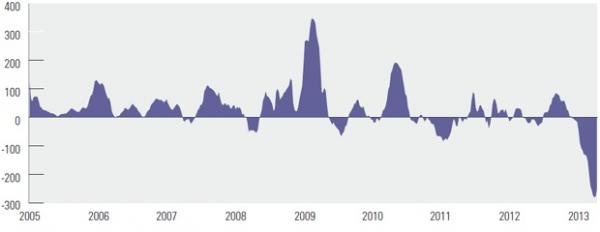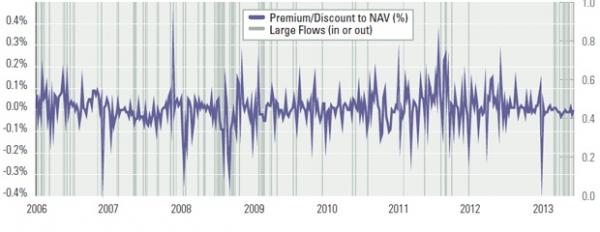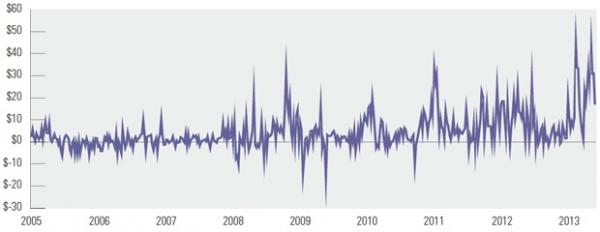In their latest newsletter, the good folks at Sprott Asset Management tackle the ongoing redemptions of the GLD.
Again, you can receive these newsletters directly if you click this link and sign up: https://www.industrymailout.com/Industry/View.aspx?id=454626&q=598417271&qz=7aa03e
Redemptions in the GLD are, oddly enough, Bullish for Gold
By Eric Sprott & Etienne Bordeleau
Recent outflows from physical gold exchange traded products (we use the SPDR Gold Shares, GLD) have been interpreted by the financial press as a sign of weakness in the demand for gold as an investment vehicle.1
However, a closer look at the evidence suggests otherwise: the largest outflows in the history of the GLD (see Figure 1) started well before the large drop in the price of gold we observed on April 15th, 2013 (-9%, which represents a 1 in 11 years event)2. In fact, the net redemption of shares of GLD started as early as the second week of January 2013 (on a 3-month cumulative rolling basis). In this note, we will explore the theory that it was the shortage of physical gold and the ensuing arbitrage opportunity that drove market participants to redeem shares of GLD.
So why are the bullion banks3 that act as Authorized Participants for GLD, a group that includes JP Morgan and HSBC and others (who by-the-way were mostly bearish on gold leading to the April Crash), redeeming so many shares of GLD?
One explanation could be that they are trying to match supply and demand so that the net asset value (NAV) of the ETF is in line with its price. Historically, we have observed that large movements in and out of the GLD are associated with large discounts/premiums to NAV (Figure 2). This is due to the constant creation/redemption of the shares to minimize the discrepancies between the ETF share price and the NAV. However, the recent wave of redemptions has occurred even while the premium to NAV has been very stable, hovering around 0% for most of the year.
FIGURE 1: FLOWS IN THE GLD (TONNES) - 3 MONTH ROLLING BASIS
Source: SPDRgoldshares.com and Sprott Calculations.
Last Observation: May 28, 2013 (Week 22).
FIGURE 2: GLD PREMIUM TO NAV AND GOLD FLOWS
Source: SPDR Gold Trust, Sprott Calculations.
Note: Large flows are defined as weeks where the average % change in tonnes lies in the top or bottom 10% of its distribution (i.e. tail events).
We believe that the answer lies in the discrepancy between the paper and physical markets for gold. Over the past few months, there have been rumours of bullion bank customers unable to redeem their gold.4,5 While, at the same time, physical demand in Asia has been extremely strong this year.6,7 According to the World Gold Council (WGC), Indian imports should reach 230-400 tonnes in Q2 2013 (an increase of more than 200% year-over-year) and imports from China keep breaking records (the WGC now forecasts total Chinese imports of 880 tonnes for 2013).8 This is reflected in the large premium customers in these markets pay over the “London Fix”, the price one should be able to get for physical gold. One way to measure the extent of the demand imbalance for physical gold in Asia is to look at what has been termed the “Shanghai Premium”, which is the difference between the quoted physical gold price on the Shanghai Gold Exchange and the London Fix gold price. Figure 3 above shows a weekly time series of the Shanghai premium in USD/oz. of gold. Since the beginning of the year, the Shanghai premium has been consistently above zero and historically large, reaching more than $50 per oz.
FIGURE 3: SHANGHAI PREMIUM (GOLD, $/OZ)
Source: Bloomberg. Last Observation: May 28, 2013 (Week 22).
Definition: Shanghai Gold Exchange Au9999 Gold (USD) minus London Gold Market Fixing Ltd - LBMA AM Fixing Price/USD.
“The Shanghai Premium is calculated on a weekly basis. Formula: (SHGF9999 Index * CNYUSD Curncy * 31.1g/oz) - GOLDLNAM Index”.
PUTTING THE PIECES TOGETHER
It is clear that demand for physical gold in Asia is strong and that the price of gold in these markets is well above the “Western” price. This creates arbitrage opportunities for market participants that have access to large and cheap quantities of physical gold in the West. The bullion banks happen to be the only ones able to redeem GLD shares for gold, and the GLD, with its 1,000 tonnes of inventory, acts like a large physical gold bank.
FIGURE 4: SHANGHAI PREMIUM ($/OZ) AND GLD FLOWS
Source: Bloomberg, SPDR Gold Trust, Sprott Calculations.
Note: Shanghai Premium shown as a 3-month Moving Average GLD flows are rolling cummulative flows over 3 months
According to the GLD prospectus, the bullion banks can create or redeem units for as little as 10bps (0.10%). Even with transport and insurance costs (which are arguably lower for large transactions and large international banks), there is a clear arbitrage opportunity for the bullion banks when the Shanghai premium (or any other physical gold price premium in emerging markets) is as large as it has been recently.
Moreover, because of the intense demand for physical gold we have seen so far this year, it is very probable that the bullion banks themselves are in a shortage of physical gold, hence the need to use the GLD reserves.
Indeed, since 2005, there has been a strong negative correlation between GLD flows and the Shanghai Premium (-53%) (Figure 4 above). This means that large outflows (redemptions) from the GLD are typically associated with high premiums in the Shanghai gold market. This association has been particularly marked since the beginning of the year, with historically large outflows corresponding to an all-time high in the Shanghai premium.
To conclude, the evidence presented here suggests that, contrary to what has been stated in the financial press, the flows out of the SPDR Gold Trust may have been generated by the bullion banks to take advantage of an arbitrage opportunity in the physical market. This arbitrage opportunity occurred because of the intense demand for gold stemming from Asia and the inability of traditional suppliers to provide this gold (hence the large Shanghai premium). We believe that this activity further supports our hypothesis that there is a lack of availability of physical gold and an obvious dislocation between the physical and paper gold markets.
In these conditions, it is not hard to imagine that prior to April 15, the bullion dealers, with their large resources, were tempted to sell large amounts of gold futures in order to lower the spot price and make the arbitrage even more profitable by increasing the spread and sparking a tsunami of buying in Asia.
To us, this is clearly a bullish signal for gold.
1 https://www.bloomberg.com/news/2013-05-22/gold-etp-outflows-in-2013-topa... over-past-two-years-1-.html
2 We say approximately 1 in 11 years because a -9% move is about a 7 standard deviations change and, given that gold price returns follow a Student distribution with about 5 degrees of freedom, this should happen every 10 years (or 2800 trading days). Some have proclaimed that it is a much rarer event, but this would assume that gold prices follow a normal distribution, which is simply false.
3 The bullion banks are: the Bank of Nova Scotia – ScotiaMocatta, Barclays Bank PLC, Credit Suisse, Deutsche Bank AG, Goldman Sachs International, HSBC Bank USA, N.A., JPMorgan Chase Bank, N.A., Mitsui & Co Precious Metals Inc., Merrill Lynch International Bank Limited, Société Générale and UBS AG.
4 https://poorrichards-blog.blogspot.com.au/2013/05/clients-denied-gold-at... banks-as.html
5 https://truthingold.blogspot.co.uk/2013/04/the-global-fractional-paperbu... 6103.html
6 https://sprottgroup.com/thoughts/articles/where-is-the-gold-coming-from/
7 https://sprottgroup.com/thoughts/articles/the-golden-answer-to-chineseim... data/
8 https://www.reuters.com/article/2013/05/29/gold-demand-wgcidUSL5N0E93U92...





